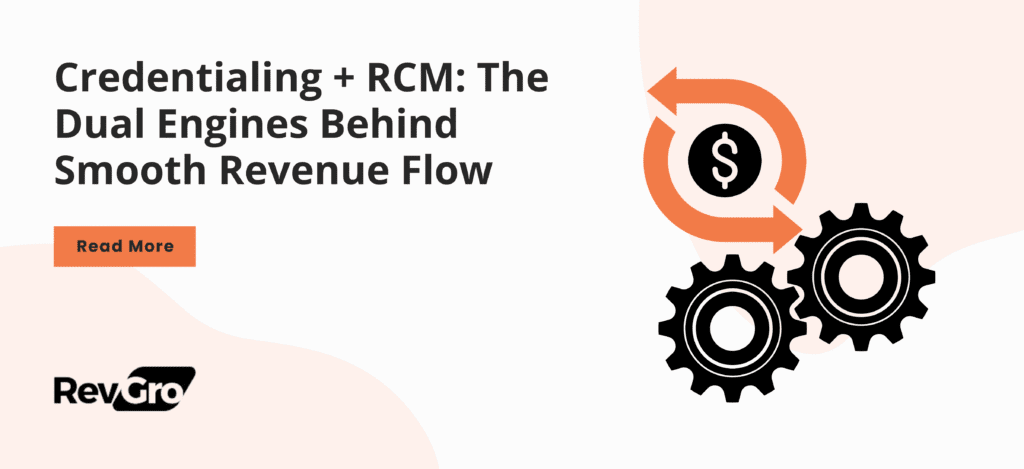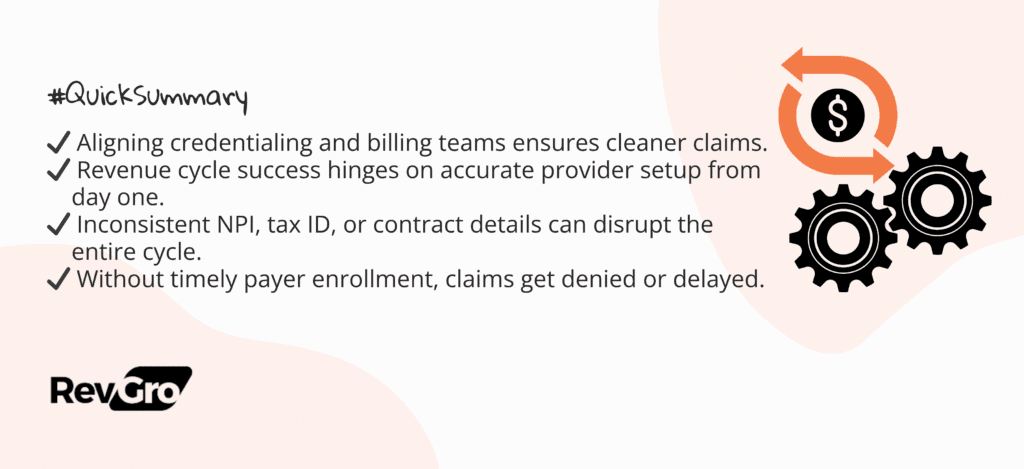
- Credentialing: The Foundation of Revenue Cycle Management
- How Credentialing Fuels Efficient Revenue Cycle Management
- The Financial Impact of Proper Credentialing on RCM
- The Operational Efficiency of Credentialing and RCM Integration
- Credentialing and RCM: A Collaborative Approach to Patient Satisfaction
- Building a Stronger Financial Future with Credentialing and RCM
In today’s fast-evolving healthcare environment, effective management of both credentialing and revenue cycle management (RCM) is critical to ensure smooth operations, maximized revenue, financial stability, and patient satisfaction. While these two processes are often treated separately, they are actually deeply interconnected and play a pivotal role in the financial health of a practice.
In this blog, we will explore how credentialing and RCM work together as dual engines to optimize revenue flow, reduce administrative burdens, and ensure a seamless experience for both providers and patients.

Credentialing: The Foundation of Revenue Cycle Management
Credentialing is the process by which healthcare providers are validated by insurance companies, ensuring that they meet certain qualifications and regulations. This process is fundamental because, without proper credentialing, providers are unable to participate in payer networks, making it impossible to submit claims and receive payment for services rendered.
Why Credentialing Matters for Your Revenue Cycle
- Expands Patient Access: Credentialing allows your practice to expand its network affiliations, giving more patients the ability to use their insurance to pay for services.
- Enables Timely Reimbursements: Credentialing ensures faster claims submissions and reduces the chances of delayed reimbursements. If your practice isn’t properly credentialed, your claims may be rejected or delayed, affecting cash flow.
- Supports Versatile Insurance Coverage: When your providers are credentialed, you can accept a broader range of insurance providers, which translates to higher patient volumes and higher revenue potential.
In essence, successful credentialing is the cornerstone of a strong revenue cycle. Without accurate and timely credentialing, the entire revenue cycle can be disrupted before it even begins.
Once your practice is properly credentialed, you can seamlessly move into the RCM process, which focuses on managing the financial aspects of patient care—from coding to billing to payment collections. RCM ensures that the services you provide are properly billed and paid by insurance companies and patients.
How Credentialing supports RCM
- Claims Accuracy: Proper credentialing ensures that the billing codes used during patient visits are accurate, which helps prevent errors that can lead to denied claims. When supported by correct credentialing, RCM tools can process claims more accurately and quickly.
- Faster Claims Processing: The credentialing process ensures that your practice is accepted by payers, which means your claims won’t be delayed or rejected. By having credentialed providers, RCM processes can begin right away, minimizing the time it takes to receive payment for services rendered.
- Compliance and Reimbursement: Credentialing and RCM also work hand in hand to ensure regulatory compliance and secure reimbursement rates. With credentialing in place, your RCM system can focus on collecting payments efficiently and maximizing reimbursements from insurers.
For healthcare practices, the financial implications of both credentialing and RCM are substantial. Here’s how effective credentialing directly impacts the financial health of your practice:
Faster Cashflows with Fewer Denials
A key benefit of credentialing is its ability to reduce claim denials and delays. A practice that isn’t properly credentialed may find that its claims are consistently denied or delayed by insurance companies. Denied claims require time-consuming follow-ups and resubmissions, which ultimately delay payments and increase operational costs.
With credentialing in place, however, your practice’s claims submission process becomes much smoother, resulting in faster reimbursement and more efficient management of patient balances.
Improving Cash Flow with Credentialing and RCM Integration
By combining proper credentialing with efficient RCM processes, practices can enjoy better cash flow. Credentialing enables providers to submit claims quickly, while RCM ensures these claims are properly processed and paid. The result? Faster payment cycles, improved revenue flow, and minimized delays. Practices with integrated credentialing and RCM see up to 20% faster reimbursement turnaround times.
The integration of credentialing and RCM leads to operational efficiency—one of the most significant advantages for healthcare providers. When these two functions work seamlessly, administrative workloads decrease, and the practice’s financial management becomes smoother.
Automating Credentialing and RCM Processes
- Faster and Error-Free Onboarding and Enrollment: Using automated credentialing software allows practices to streamline the application and verification process, ensuring that credentialing tasks are completed faster and with fewer errors.
- RCM Tools that simplify collections and claims: By integrating RCM tools into your practice management system, you can automate the claims submission, follow-ups, and collections processes, freeing up your staff to focus on patient care rather than administrative tasks.
When your credentialing process is automated and integrated with your RCM system, you can reduce administrative overhead and focus on providing quality care while ensuring that the revenue cycle runs efficiently.
Credentialing and RCM: A Collaborative Approach to Patient Satisfaction
Although credentialing and RCM primarily focus on the financial side of your practice, they also have a direct impact on patient satisfaction.
How Proper Credentialing Enhances the Patient Experience
- Easier Access to Care: Credentialing removes insurance-related stress for patients, allowing them to schedule care confidently with in-network providers.
- Faster Service Delivery: A streamlined credentialing process and efficient RCM system lead to faster billing and less paperwork for patients, making their overall experience more convenient.
RCM’s Role in Improving Patient Experience
- Clear Billing Statements: A well-run RCM process ensures that patients receive clear and accurate billing statements. This transparency reduces confusion and the likelihood of payment disputes.
- Efficient Payment Collection: Automated RCM systems allow for easy online payments, payment plans, and reminders, improving patient satisfaction and increasing the likelihood of timely payments.
Building a Stronger Financial Future with Credentialing and RCM
Credentialing and RCM are not just back-office tasks—they’re strategic levers that power your practice’s financial success and patient satisfaction. Credentialing ensures that your practice can access the right payer networks and submit claims for timely reimbursement, while RCM ensures these claims are processed correctly and payments are collected swiftly.
For long-term financial success, practices must view credentialing and RCM as complementary functions that support each other. By streamlining both, practices can enjoy a smoother revenue cycle, reduce administrative costs, improve cash flow, and ultimately boost patient satisfaction.
RevGroMD helps you simplify, streamline, and scale your credentialing and RCM—so you can focus on delivering care, not chasing claims. Let’s grow your revenue together.
